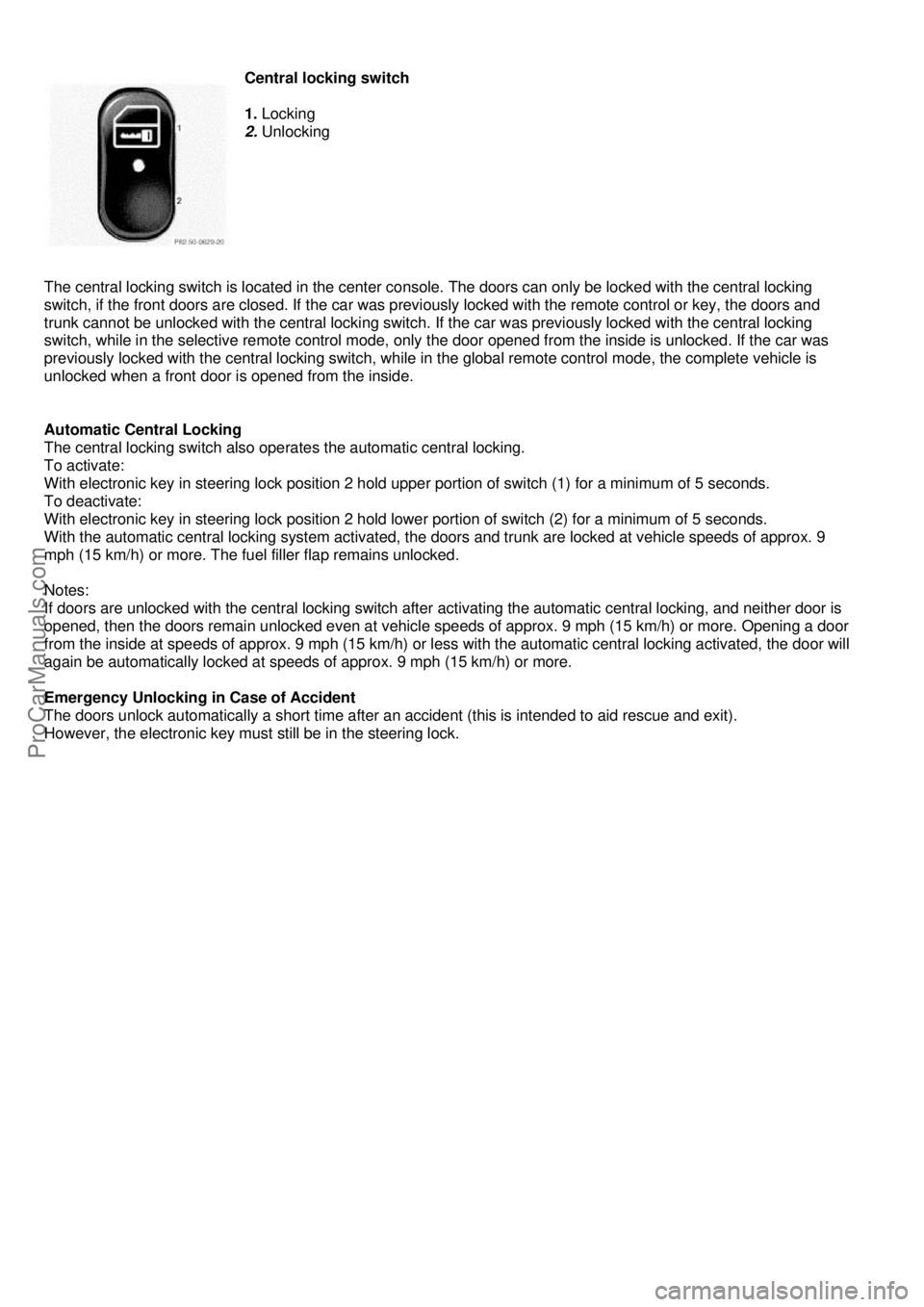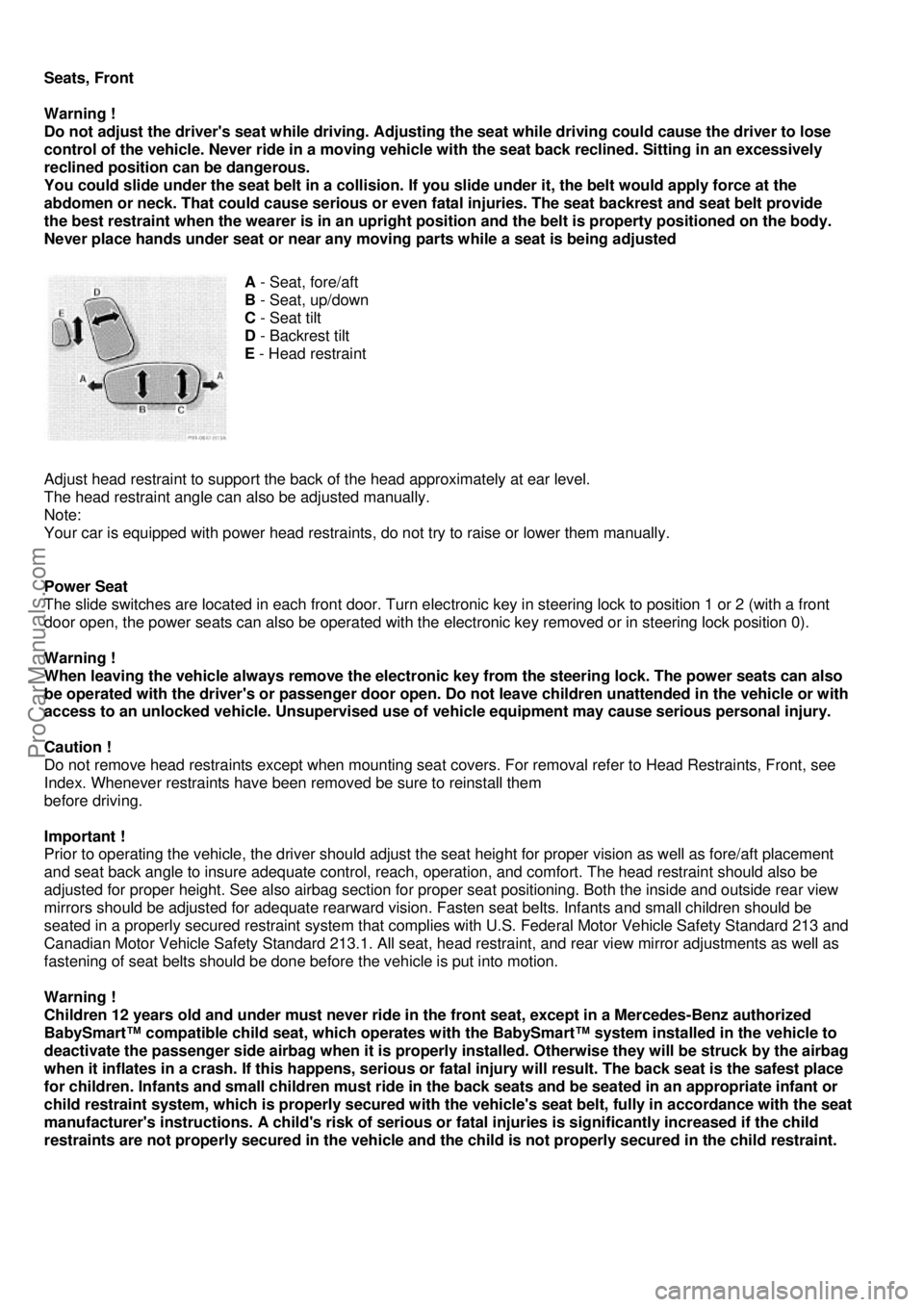1999 MERCEDES-BENZ C-280 steering
[x] Cancel search: steeringPage 16 of 122

Start Lock-Out
Important !
Removing the electronic key from the steering lock activates the start lock-out. The engine cannot be started.
Inserting the electronic key in the steerin g lock deactivates the start lock-out.
Note:
In case the engine cannot be started, the system is not operational. Contact an authorized Mercedes-Benz
dealer or call 1-800-FOR-MERCedes.
ProCarManuals.com
Page 18 of 122

Locking and Unlocking
Unlocking:
Press transmit button
. All turn signal lamps blink once to indicate that the vehicle is unlocked.
The remote control can be programmed for two kinds of unlocking methods (see below): Selective
unlocking mode. Press transmit button
once to unlock driver's door and fuel filler flap. Press
transmit button
twice to unlock doors, fuel filler flap, and trunk. Global unlocking mode - Press
transmit button
once to unlock doors, fuel filler flap, and trunk.
Notes:
If the trunk was previously locked separately, it will remain locked (see Index). The presently active
unlocking mode (selective or global) can only be determined by unlocking the vehicle with the
remote control (see below for changing mode). The vehicle is automatically locked again, if within 40
seconds of unlocking with the remote control, neither door or trunk is opened, the electronic key is
not inserted in the steering lock, or the central locking switch is not activated.
Locking:
Press transmit button
once. All turn signal lamps blink three times to indicate that the vehicle is
locked
.
Note:
If the vehicle cannot be locked or unlocked by pressi ng the transmit button, then it may be necessary
to change the batteries in the transmitter (if ok, battery check lamp in transmitter will light briefly
when transmitting) or to synchronize the system, see Remote Control in Index.
Choosing Global or Selective Mode on Remote Control
Press and hold transmit buttons
and simultaneously for five seconds to reprogram the
remote control. Battery check lamp will blink two times indicating the completed mode change.
ProCarManuals.com
Page 20 of 122

Panic Button
To activate press and hold button (1) for at least one second. The
alarm will last for approximately 3 minut es in form of blinking exterior
lamps, and an additional horn will sound intermittently
To deactivate press button (1) again, or insert electronic key in
steering lock.
Note:
For operation in the USA only: This devise complies with Part 15 of the FCC Rules. Operation is subject to the
following two conditions: (1) This device may not cause har mful interference, and (2) this device must accept any
interference received, including interference that may cause undesired operation. Any unauthorized modification to
this device could void the user's authority to operate the equipment.
Mechanical Keys
The entire vehicle may be locked or unlocked by using either t he mechanical key in driver's door or trunk lock, or
central locking switch located in center console. The central locking system also locks or unlocks the fuel filler flap.
Note:
If the fuel filler flap cannot be opened, refer to Fuel Filler Flap, Manual Release (see Index).
ProCarManuals.com
Page 22 of 122

Central locking switch
1. Locking
2. Unlocking
The central locking switch is located in the center cons ole. The doors can only be locked with the central locking
switch, if the front doors are closed. If the car was previously locked with the remote control or key, the doors and
trunk cannot be unlocked with the central locking switch. If the car was previously locked with the central locking
switch, while in the selective remote control mode, only the door opened from the inside is unlocked. If the car was
previously locked with the central locking switch, while in the global remote control mode, the complete vehicle is
unlocked when a front door is opened from the inside.
Automatic Central Locking
The central locking switch also oper ates the automatic central locking.
To activate:
With electronic key in steering lock position 2 hold upper portion of switch (1) for a minimum of 5 seconds.
To deactivate:
With electronic key in steering lock position 2 hold lower portion of switch (2) for a minimum of 5 seconds.
With the automatic central locking system activated, the doors and trunk are locked at vehicle speeds of approx. 9
mph (15 km/h) or more . The fuel filler flap remains unlocked.
Notes:
If doors are unlocked with the central locking switch after activating the automatic central locking, and neither door is
opened, then the doors remain unlocked even at vehicle speeds of approx. 9 mph (15 km/h) or more. Opening a door
from the inside at speeds of approx. 9 mph (15 km/h) or less with the automatic central locking activated, the door will
again be automatically locked at speeds of approx. 9 mph (15 km/h) or more.
Emergency Unlocking in Case of Accident
The doors unlock automatically a short time after an a ccident (this is intended to aid rescue and exit).
However, the electronic key must still be in the steering lock.
ProCarManuals.com
Page 26 of 122

Seats, Front
Warning !
Do not adjust the driver's seat while driving. Adjusting the seat while driving could cause the driver to lose
control of the vehicle. Never ride in a moving vehicle with the seat back reclined. Sitting in an excessively
reclined position can be dangerous.
You could slide under the seat belt in a collision. If you slide under it, the belt would apply force at the
abdomen or neck. That could cause serious or even fatal injuries. The seat backrest and seat belt provide
the best restraint when the wearer is in an upright position and the belt is property positioned on the body.
Never place hands under seat or near any moving parts while a seat is being adjusted
A - Seat, fore/aft
B - Seat, up/down
C - Seat tilt
D - Backrest tilt
E - Head restraint
Adjust head restraint to support the back of the head approximately at ear level.
The head restraint angle can also be adjusted manually.
Note:
Your car is equipped with power head restraints , do not try to raise or lower them manually.
Power Seat
The slide switches are located in each front door. Turn elec tronic key in steering lock to position 1 or 2 (with a front
door open, the power seats can also be operated with the electronic key removed or in steering lock position 0).
Warning !
When leaving the vehicle always remove the electronic key from the steering lock. The power seats can also
be operated with the driver's or passenger door open. Do not leave children unattended in the vehicle or with
access to an unlocked vehicle. Unsupervised use of vehicle equipment may cause serious personal injury.
Caution !
Do not remove head restraints except when mounting seat co vers. For removal refer to Head Restraints, Front, see
Index. Whenever restraints have been removed be sure to reinstall them
before driving.
Important !
Prior to operating the vehicle, the driv er should adjust the seat height for proper vision as well as fore/aft placement
and seat back angle to insure adequate control, reach, operation, and comfort. The head restraint should also be
adjusted for proper height. See also airbag section for prope r seat positioning. Both the inside and outside rear view
mirrors should be adjusted for adequate rearward vision. Fasten seat belts. Infants and small children should be
seated in a properly secured restraint system that complies with U.S. Federal Motor Vehicle Safety Standard 213 and
Canadian Motor Vehicle Safety Standard 213.1. All seat, head restraint, and rear view mirror adjustments as well as
fastening of seat belts should be done before the vehicle is put into motion.
Warning !
Children 12 years old and under must never ride in the front seat, except in a Mercedes-Benz authorized
BabySmart™ compatible child seat, which operates with the BabySmart™ system installed in the vehicle to
deactivate the passenger side airbag when it is properly installed. Otherwise they will be struck by the airbag
when it inflates in a crash. If this happens, serious or fatal injury will result. The back seat is the safest place
for children. Infants and small children must ride in the back seats and be seated in an appropriate infant or
child restraint system, which is properly secured with the vehicle's seat belt, fully in accordance with the seat
manufacturer's instructions. A child's risk of serious or fatal injuries is significantly increased if the child
restraints are not properly secured in the vehicle and the child is not properly secured in the child restraint.
ProCarManuals.com
Page 28 of 122

Multicontour Seat (optional)
1. Seat cushion depth
2. Backrest bottom
3. Backrest center
4. Side bolster adjustment
Some models may be equipped with multicontour seats. These seats have movable seat cushions,
and inflatable air cushions built into the backrest to provide additional lumbar and side support.
The seat cushion movement and amount of backrest cushion height and curvature can be
continuously varied with regulators (1, 2 and 3) after turning the electronic key in steering lock to
position 2.
The side bolsters of the backrest can be adjusted with rocker switch (4):
• press down forward end-increase side support,
• press down rearward end-decrease side support.
If the engine is turned off, the last cushion setting is retained in memory, and automatically adjusts
the cushion to this setting when the engine is restarted.
ProCarManuals.com
Page 29 of 122

Heated Seats (optional)
The front seat heater switches are located in the center console. The front seat heaters
can be switched on with the electronic key in steering lock positions 1 or 2.
Press switch to turn on heater:
1. Normal heating mode. One indicator lamp in the switch lights up.
2. Rapid heating mode. Bo indicator lamps in the switch light up. After approximately
5 minutes in the rapid heating mode, the heater automatically witches to normal
operation and only one indicator lamp will stay on.
Turning off heater:
If one indicator lamp is on, press upper half of switch.
If both indicator lamps are on, press lower half of switch.
If left on, the heater automatically turns off after approximately 30 minutes of operation.
Note:
When in operation, the seat heater consumes a large amount of electrical power. It is not advisable to use the seat
heater longer than necessary. The seat heaters may automatically switch off if too many power consumers are
switched on at the same time, or if the battery charge is lo w. When this occurs, the indicator lamp in the switch will
blink (both indicator lamps blink during rapid seat heating) . The seat heaters will switch on again automatically as
soon as sufficient voltage is available. If the blinking of the indicator lamps is distracting to you, the seat heaters can
be switched off.
ProCarManuals.com
Page 30 of 122

Armrest (Rear Bench Seat)
Pull down the armrest. For removal of rear seat cushion, see Index.
Cup Holder in Rear Bench Armrest
Briefly press drawer and pull out to its detent.
Caution!
Keep cup holder closed while travelling. Place only containers
that fit into the cup holder to prevent spills.
Do not fill containers to a height where the contents could spill
during vehicle maneuvers, especially hot liquids.
Adjusting Telescoping Steering Column (optional)
Warning!
Do not adjust the steering wheel while driving. The telescoping
adjustment must be locked while driving. Adjusting the steering
wheel while driving, or driving without the telescoping adjustment
locked could cause the driver to lose control of the vehicle.
Unlocking:
Pull handle (1) out to its stop. The indicator lamp comes on.
Adjusting:
To lengthen or shorten the steering column, pull out or push in steering wheel.
Locking:
Push handle (1) in until it engages.
The indicator lamp goes out.
Important!
With the electronic key in steering lock position 2, an indicator lamp in the instrument cluster comes on. It should go
out when the engine is running. If the indicator lamp does not go out after starting the engine, the adjustable steering
column is not locked properly. Do not drive the vehi cle until you have properly locked the steering column.
ProCarManuals.com